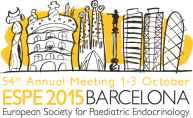
54th Annual ESPE
Barcelona,
Spain
01 Oct 2015 - 03 Oct 2015
hrp0084p1-122 | Thyroid | ESPE2015
Congenital Hypothyroidism in Twin Couples and Triplets
Olivieri Antonella , Weber Giovanna , Cassio Alessandra , Costa Pietro , Calaciura Francesca , Medda Emanuela , Vigone Maria Cristina , De Filippis Tiziana , Gelmini Giulia , Marelli Federica , Di Russo Valeria , Persani Luca
hrp0084p1-123 | Thyroid | ESPE2015
Th17 Cells in Children with Graves’ Disease During Methimazole Treatment
Klatka Maria , Grywalska Ewelina , Rolinski Jacek
hrp0084p1-124 | Thyroid | ESPE2015
Thyrocytes are Particularly well Protected Against Oxidative Stress Induced by H2O2
Ghaddhab Chiraz , Van Den Eeckhaute Emmanuel , Hancisse Olivier , Driessens Natacha , Dumont Jacques-Emile , Miot Francoise , Corvilain Bernard
hrp0084p1-125 | Thyroid | ESPE2015
Thyrocyte is Particularly Well Protected Against Oxidative Stress Induced by H2O2
Ghaddhab Chiraz , Van Den Eeckhaute Emmanuel , Hancisse Olivier , Driessens Natacha , Versteyhe Soetkin , Miot Francoise , Dumont Jacques-Emile , Corvilain Bernard
hrp0084p1-126 | Thyroid | ESPE2015
Characteristics and Outcome of Neonates with Congenital Hypothyroidism Born After In Vitro Fertilisation
Giogli Vassiliki , Kanaka-Gantenbein Christina , Arditi Jessica-Debora , Platis Dimitris , Chouliaras George , Kourkouti Chrysoula , Kosteria Ioanna , Gika Anna , Iliadi Alexandra , Chrousos George , Girginoudis Panagiotis , Voutetakis Antonis
hrp0084p1-127 | Thyroid | ESPE2015
Transient vs Permanent Congenital Hypothyroidism: The Use of Baseline Characteristics and Long-Term Data Can Help Formulate a Practical Prognostic Algorithm
Giogli Vassiliki , Kanaka-Gantenbein Christina , Chouliaras George , Arditi Jessica-Debora , Gika Anna , Iliadi Alexandra , Platis Dimitris , Kyritsi Eleni Magdalini , Karkalousos Petros , Karikas George-Albert , Mengreli Chrysanthi , Chrousos George , Girginoudis Panagiotis , Voutetakis Antonis
hrp0084p1-128 | Thyroid | ESPE2015
Diverse Genotypes and Phenotypes of Three Novel Thyroid Hormone Receptor α Mutations
Demir Korcan , van Gucht Anja , Buyukinan Muammer , Catli Gonul , Ayhan Yavuz , Bas Veysel Nijat , Dundar Bumin Nuri , Ozkan Behzat , Meima Marcel E , Visser W Edward , Peeters Robin P , Visser Theo J
hrp0084p1-129 | Thyroid | ESPE2015
Intelligence and Behaviour in Children and Adolescents with Hashimoto’s Thyroiditis
Boettcher Claudia , Brosig Burkhard , Windhaus Henriette , Wudy Stefan A , Hahn Andreas
hrp0084p1-130 | Thyroid | ESPE2015
Brain-Lung-Thyroid Syndrome – Update on the Clinical Spectrum of a Heterogeneous Disorder
Lenherr Nina , Vuissoz Jean-Marc , Heinimann Karl , Szinnai Gabor
hrp0084p1-131 | Thyroid | ESPE2015
Increased Detection Rate of Paired Box Domain Gene Mutations by Application of Multiplex Ligation-Dependent Probe Amplification Analysis in Patients with Primary Congenital Hypothyroidism and Thyroid Dysgenesis
Kumorowicz-Czoch Malgorzata , Hermanns Pia , Madetko-Talowska Anna , Pohlenz Joahim
hrp0084p1-132 | Thyroid | ESPE2015
Severe Hyperthyroidism in an Infant Revealed a Familial Non-Autoimmune Hyperthyroidism with Novel Heterozygous Thyrotropin Receptor Gene Mutation
Petit Isabelle Oliver , Savagner Frederique , Edouard Thomas , Caron Philippe



